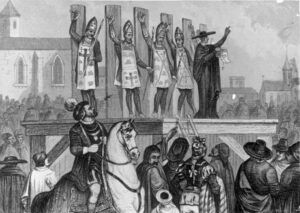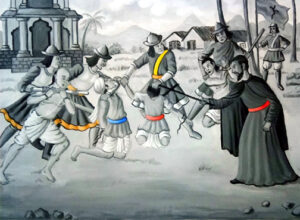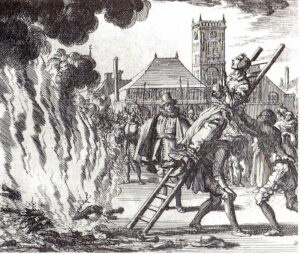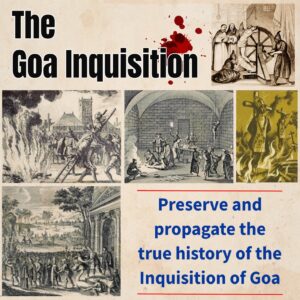[ Reported as seen ]
The Goa Inquisition, initiated in 1560 by the Portuguese authorities, aimed to eradicate non-Christian practices in their Indian territories. It suppressed indigenous religions, destroyed Hindu temples, and persecuted Jews and Muslims. Discriminatory measures included restrictions on Hindu practices and symbols. The Inquisition conducted numerous trials, prosecuting around 16,172 individuals, mostly natives. Punishments were severe, including public penance and burning at the stake. The Inquisition’s abolition in 1774 left a lasting impact, instilling fear, suppressing customs, and eroding religious freedom and cultural heritage. It serves as a reminder of the dangers of religious intolerance and the need for respect and diversity.
Introduction
The Goa Inquisition, also known as the Inquisição de Goa, was an extension of the Portuguese Inquisition in Portuguese India during the 16th to 19th centuries. Its primary objective was to enforce Catholic Orthodoxy and loyalty to the Roman Catholic Church. This led to the persecution of Hindus, the destruction of Hindu temples, and the forced conversions of individuals through the Inquisition’s activities.
The Inquisition in Goa focused on two main groups: the New Christians, who were accused of secretly practicing their former religions, and the Old Christians, who were accused of involvement in the Protestant Reformation. Established in 1560, the Inquisition operated until its abolition in 1812, with a brief period of suppression from 1774 to 1778. Those accused of practicing Hinduism in secret while posing as Christians faced imprisonment or even death if convicted.
In addition to religious persecution, the Inquisitors also targeted books written in Sanskrit, Dutch, English, or Konkani, suspecting them to contain deviationist or Protestant material. These books were seized and burned as part of their efforts to eliminate any perceived threats to Catholicism.
The Portuguese Empire in Asia had three main goals: combating Islam, spreading Christianity, and establishing profitable trade routes for spices. The Portuguese were driven by missionary zeal and intolerance, exemplified by missions like the Madura Mission and the Jesuit mission to the court of Emperor Akbar. The Inquisition played a role in enforcing the subjection of the Syrian Church to the Roman Church.
While exact figures are unknown due to the destruction of records, it is estimated that around 16,000 individuals were charged during the Inquisition’s existence. Many records were deliberately burned when the Inquisition was abolished, making it difficult to determine the exact number of trials and punishments. Surviving records indicate that at least 57 individuals were executed for religious crimes, while 64 were burned in effigy as they had already died in jail before sentencing.
By the end of the 17th century, Christianization had significantly reduced the non-Christian population in Goa, with fewer than 20,000 non-Christians out of a total population of 250,000. The Inquisition intensified in the 17th century, targeting practices like offerings to local deities, which were viewed as witchcraft.
The Inquisition in Goa also extended its prosecution to those who practiced Hindu or Muslim rituals, as well as individuals who impeded Portuguese attempts to convert non-Christians. The laws of the Inquisition criminalized reconversion to Hinduism, Islam, or Judaism, as well as the use of the Konkani language and Sanskrit. Discrimination against Hindus persisted even after the formal end of the Inquisition in 1812, in the form of taxes such as the Xenddi tax, similar to the Jizya tax.
Religious discrimination finally came to an end with the introduction of secularism through the Portuguese Constitution of 1838 and the subsequent Portuguese Civil Code of Goa and Damaon.
Background
The origins of the Goa Inquisition can be traced back to the late 15th century when Ferdinand and Isabella, the monarchs of Spain, expelled the Jewish population from their kingdom in 1492. Many of the expelled Jews sought refuge in Portugal, where anti-Judaism sentiments were also on the rise. In 1497, the King of Portugal ordered the forced conversion of the Jews, creating a community of New Christians or Crypto-Jews. These New Christians faced persecution and discrimination in Portugal.
Meanwhile, Portugal was establishing its presence in India. Vasco da Gama’s arrival in India in 1498 paved the way for Portuguese conquest and colonization. Goa, which had a rich history and had been ruled by various Hindu and Muslim dynasties, was captured by the Portuguese in 1510 under the leadership of Admiral Afonso de Albuquerque. Goa became the center of Portuguese colonial possessions in India and an important trading hub between the Portuguese, the Hindu Vijayanagara Empire, and the Muslim Bijapur Sultanate.
The Portuguese, driven by their mission to spread Christianity, established churches and supported missionary efforts in Goa. They also sent missionaries to other parts of Asia. The papal bull Romanus Pontifex granted Portugal the responsibility and monopoly rights for propagating the Catholic Christian faith in newly discovered areas, including Asia. Goa became a center for missionary activities under the royal patronage (Padroado) of Portugal. The Jesuits were particularly active in Goa and other Portuguese colonies, working to convert Hindus, Muslims, and Crypto-Jews to Christianity.
The presence of the New Christians in India, who had fled from persecution in Portugal, became a source of concern for the Portuguese authorities. The New Christians played a significant role in trade and had thriving economic networks. They also had the opportunity to reconnect with ancient Jewish communities in India. Secular and ecclesiastical authorities in Portugal raised complaints about the trade practices and the abandonment of Catholicism by the New Christians in India. Archbishop Dom Gaspar de Leão Pereira, in particular, was influential in petitioning for the establishment of the Inquisition in Goa.
The Goa Inquisition was finally established in 1560, about 25 years after the departure of the renowned missionary Saint Francis Xavier, who had advocated for its establishment. The Inquisition aimed to combat heresy, including the practices of Crypto-Hindus, Crypto-Muslims, and Crypto-Jews. The directives issued by the Council of Trent in the mid-16th century, emphasizing the purity of Catholic faith, were adapted to the Goan context.
The Inquisition was characterized by interrogations, trials, and punishments for those accused of secretly practicing their former religions or engaging in practices considered heretical. The Inquisitors also targeted violators of Hindu and Muslim rituals, as well as those who interfered with Portuguese attempts to convert non-Christians to Catholicism. The Inquisition had a significant impact on the religious and social fabric of Goa, leading to forced conversions, destruction of Hindu temples, and the suppression of local customs and practices.
The Goa Inquisition continued for over two centuries, with around 16,000 individuals charged during its existence. Most of the records were destroyed when the Inquisition was abolished in 1812, making it difficult to ascertain the exact number of trials and punishments. However, surviving records indicate that at least 57 individuals were executed for religious crimes.
The discrimination against Hindus under Portuguese Christian rule persisted even after the abolition of the Inquisition. Measures like the Xenddi tax, similar to the Jizya tax, were implemented until the introduction of secularism through the Portuguese Constitution of 1838. It marked the end of religious discrimination in Goa, but the legacy of the Inquisition continued to shape the history and cultural landscape of Goa.
The Goa Inquisition left a lasting impact on the history and cultural landscape of Goa. It led to the suppression of local customs and practices, the destruction of Hindu temples, and the forced conversions of individuals. The Inquisition aimed to establish and maintain Catholic orthodoxy in Goa, which resulted in the persecution and discrimination of Hindus, Muslims, and Crypto-Jews.
The Inquisition had a profound effect on the Goan society, as it created an atmosphere of fear and suspicion. People lived in constant fear of being accused of heresy and subjected to harsh interrogations, trials, and punishments. The Inquisitors had extensive powers and used them to investigate and punish individuals suspected of practicing their former religions in secret.
The Inquisition also had economic implications, as it targeted the influential New Christian community. The New Christians, who were primarily engaged in trade, faced restrictions and scrutiny due to their suspected adherence to their Jewish or Muslim roots. This led to a decline in their economic influence and disrupted existing trade networks.
Furthermore, the Inquisition’s actions resulted in the destruction of many Hindu temples and the suppression of local religious practices. The Portuguese authorities sought to replace indigenous beliefs with Catholicism, leading to the loss of cultural heritage and religious freedom for the local population.
While the exact number of individuals prosecuted during the Inquisition is difficult to determine due to the destruction of records, it is estimated that thousands of people were subjected to trials and punishments. At least 57 individuals were executed for religious crimes, while others faced imprisonment, fines, and public acts of penance.
The Goa Inquisition finally came to an end in 1812 when it was abolished by the Portuguese government. However, the discriminatory practices and cultural impact of the Inquisition continued to shape Goan society for years to come.
In modern times, the Goa Inquisition is remembered as a dark period in Goan history. It serves as a reminder of the consequences of religious intolerance, forced conversions, and the suppression of cultural diversity. Efforts have been made to preserve the memory of the Inquisition and promote interfaith dialogue and understanding in Goa.

Today, Goa is a vibrant and diverse state in India, known for its beautiful beaches, unique blend of Indian and Portuguese influences, and rich cultural heritage. The scars of the Goa Inquisition are still present, but the state has moved forward, embracing religious pluralism and tolerance. The legacy of the Inquisition serves as a reminder of the importance of upholding religious freedom and respecting cultural diversity in any society.
The inquisition
The Inquisition in Goa, established in 1560, was a period of religious persecution and intolerance carried out by the Portuguese authorities in their Indian territories. It was primarily aimed at eradicating any non-Christian practices and enforcing Catholic orthodoxy. The Inquisition had a profound impact on the local population, resulting in the suppression of indigenous religions, forced conversions, destruction of Hindu temples, and persecution of Jews and Muslims.
Even before the formal establishment of the Inquisition, the Portuguese government in Goa had already targeted individuals for religious crimes. Hindu temples were destroyed, and their properties were transferred to Catholic missionaries. In 1546, King John III of Portugal issued an order forbidding Hinduism, destroying Hindu temples, and punishing those who practiced Hinduism in Portuguese territories in India. These actions laid the groundwork for the later establishment of the Inquisition.
The Goa Inquisition was initiated when Cardinal Henrique of Portugal appointed Aleixo Díaz Falcão as the first inquisitor and established the first tribunal. The Inquisition office was housed in the former palace of Sultan Adil Shah. Various orders were issued by the Inquisition, including the expulsion of qadis (Muslim judges) from Portuguese territory, the prohibition of non-Christians from holding public office, and restrictions on Hindu practices and symbols.

The discriminatory measures imposed by the Inquisition were extensive. Hindus were forbidden from producing Christian devotional objects or symbols, Hindu children whose fathers had died were required to be handed over to the Jesuits for conversion, and Hindu women who converted to Christianity could inherit all the property of their parents. Hindu temples were demolished, and Hindus were prohibited from building new temples or repairing existing ones. Hindu priests were barred from officiating Hindu weddings, and the testimony of Hindus was deemed unacceptable in legal proceedings.

The Inquisition conducted numerous trials, and from 1560 to 1774, approximately 16,172 individuals were tried by the Inquisition tribunals. The majority of those prosecuted were natives, comprising both Catholics and non-Christians. The Inquisition targeted not only Hindus but also Sephardic Jews who had sought refuge in Goa. The Inquisition records mention the demand for hundreds of prison cells to accommodate the accused.
The punishments meted out by the Inquisition were severe. Seventy-one autos de fé (“act of faith”) were recorded, which involved public penance and the execution of convicted individuals, often by burning at the stake. Over the course of the Inquisition’s existence, 57 people were burned to death, and 64 were burned in effigy. Many others were sentenced to various punishments, totaling 4,046 individuals.
The Goa Inquisition finally came to an end in 1774 when it was abolished by the Portuguese government. The Inquisition left a lasting impact on Goa’s history and cultural landscape. It instilled fear and suspicion among the population, suppressed local customs and practices, and resulted in the loss of religious freedom and cultural heritage. The legacy of the Inquisition serves as a reminder of the dangers of religious intolerance and the importance of upholding religious freedom and respecting diversity in society.
Consequences
The consequences of the Inquisition in the Indian colonies of Portugal, particularly in Goa, were far-reaching and devastating for the local population. The Inquisition, driven by the Catholic Church and the Portuguese administration, aimed to suppress and eradicate non-Christian religions, primarily targeting Hindus, Muslims, Jews, and New Christians (forcibly converted Jews and Muslims).

The Inquisition in Goa resulted in the persecution and forced conversion of Hindus. Anti-Hindu laws were enacted, which prohibited Hindus from practicing their religion and engaging in Hindu customs and rituals. Christians were banned from employing Hindus, public worship of Hindus was deemed unlawful, and Hindu books were burned. Hindu priests were also forbidden from officiating Hindu weddings. Violations of these laws led to various forms of punishment, including fines, public flogging, banishment, imprisonment, execution, and burning at the stake. As a result, many Hindus fled Goa, and there was a significant migration of Christians and Muslims from Goa to surrounding regions.
The destruction of Hindu temples was another consequence of the Inquisition. Numerous temples were razed to the ground, and Hindus were prohibited from repairing damaged temples or constructing new ones. Hindu religious ceremonies, including public weddings, were banned. Possessing an image of a Hindu god or goddess was considered a criminal offense. Non-Hindus were encouraged to report anyone who owned such images, leading to arrests and property confiscation. The Inquisition aimed to dismantle the cultural and institutional roots of Hinduism and other Indian religions.
The Inquisition also targeted Jews, particularly New Christians who had been forcibly converted to Christianity. Jews were banned from entering Portuguese territories in India, and their synagogue in Cochin was destroyed. The persecution extended to Portuguese territorial claims in Cochin, where the New Christians lived.
Goan Catholics also faced persecution under the Inquisition. Those who converted to Catholicism but continued to observe Hindu customs were considered heretics. Indigenous languages and cultural practices, such as Konkani and traditional ceremonies, were suppressed. Goan Catholics were forced to abandon their original Hindu names, and dietary habits and cultural practices underwent significant changes. The Inquisition also caused divisions within the Catholic community, with discrimination against Indian Catholic clergy by the Portuguese Catholic clergy.
The consequences of the Inquisition in Goa were severe and long-lasting. The local population faced religious discrimination, cultural suppression, and persecution. Many people were forced to flee their homes, and the destruction of temples and cultural institutions disrupted the social fabric of the community. The Inquisition not only targeted specific religious groups but also resulted in the loss of cultural heritage and the erosion of religious freedom in the region.
Today, the Goa Inquisition stands as a dark chapter in the history of Portuguese colonization and the Catholic Church’s expansion. It serves as a reminder of the consequences of religious intolerance and the suppression of diverse beliefs and practices. The memory of the Inquisition and its impact on the affected communities continues to shape the collective consciousness of the people in Goa and serves as a cautionary tale against religious persecution.
In popular literature
In 1815, Lydia Sigourney, a renowned writer, published her collection of literary works titled “Moral Pieces in Prose and Verse.” Among the poems featured in this collection was “The Destruction of the Inquisition in Goa.” Sigourney’s poem delved into the historical event of the massacre of Hindus in Goa, shedding light on the tragic episode and capturing its significance through her powerful words.
Moving forward to more recent times, in 2017, a notable Bengali writer named Avik Sarkar crafted a novel titled “Ebong Inquisition.” Set against the backdrop of the massacre of Hindus in Goa, Sarkar’s work delves deep into the ramifications of this historical event. The novel explores the complex emotions, personal narratives, and social dynamics that unfolded during this dark period, providing readers with a multi-dimensional understanding of the tragedy.
Sarkar’s novel delves into the lives of various characters affected by the massacre, painting a vivid picture of their struggles, hopes, and resilience in the face of such extreme adversity. Through his storytelling, Sarkar aims to illuminate the lasting impact of the Goa massacre on individuals, families, and communities. The novel serves as a reminder of the atrocities committed during the Inquisition and serves as a tribute to the victims who suffered in silence.
With meticulous research and a compelling narrative, Avik Sarkar’s “Ebong Inquisition” brings to life a forgotten chapter of history. The novel not only exposes the brutality of the Goa massacre but also raises important questions about religious tolerance, human rights, and the consequences of fanaticism. By exploring the emotional and psychological dimensions of the characters, Sarkar invites readers to reflect on the broader implications of religious persecution and the importance of preserving harmony in a diverse society.
In both Lydia Sigourney’s poem and Avik Sarkar’s novel, the literary works offer different perspectives on the tragic events of the Goa massacre. While Sigourney’s poem captures the essence of the historical moment, Sarkar’s novel goes beyond the facts to delve into the human experience, shedding light on the individual stories that often get overshadowed by the larger historical narrative. Together, these works contribute to a deeper understanding of the Goa massacre and its enduring significance.
Conclusion
In conclusion, the Goa Inquisition stands as a dark chapter in history, marked by religious intolerance, persecution, and violence. The Inquisition, established by the Portuguese authorities in Goa during the 16th century, aimed to enforce religious conformity and eradicate any form of dissent. It resulted in the suffering and loss of countless lives, particularly among the Hindu population.
The Goa Inquisition has left a lasting impact on the region, with its traumatic legacy embedded in the collective memory of the people. Through the years, various literary works have explored this harrowing period, shedding light on the atrocities committed and the resilience of those affected.

Lydia Sigourney’s poem, “The Destruction of the Inquisition in Goa,” offers a historical perspective, capturing the severity of the events and ensuring that they are not forgotten. By infusing her verses with emotion and vivid imagery, Sigourney immortalizes the pain and suffering endured during the Inquisition.
Avik Sarkar’s novel, “Ebong Inquisition,” published in 2017, takes a contemporary approach to the Goa Inquisition. Through storytelling and character development, Sarkar explores the human aspect of the tragedy, delving into the lives of individuals impacted by the massacre. The novel serves as a reminder of the resilience of the human spirit in the face of adversity, as well as the importance of acknowledging and learning from the mistakes of the past.
The literary works surrounding the Goa Inquisition serve as crucial reminders of the need for religious tolerance, compassion, and the preservation of human rights. They ensure that the memory of the victims is not forgotten and provide a platform for reflection and dialogue about the consequences of religious fanaticism and intolerance.
As we continue to study and reflect upon the Goa Inquisition, it is essential to draw lessons from history and strive for a world where diversity is celebrated, and religious freedom is upheld. Only through understanding, empathy, and a commitment to justice can we build a future free from the horrors of religious persecution and violence.
CITATIONS AND SOURCES
https://en.wikipedia.org/wiki/Goa_Inquisition
The Goan Inquisition by the Portuguese: A forgotten holocaust of Hindus and Jews
https://www.hindujagruti.org/goa-inquisition


![The Goa Inquisition [ Goa, India ]](https://www.projecthindukush.com/wp-content/uploads/goa-inqusition-mobile-350x450.jpg)
![The Goa Inquisition [ Goa, India ]](https://www.projecthindukush.com/wp-content/uploads/Inquisition-350x450.jpg)
![The Goa Inquisition [ Goa, India ]](https://www.projecthindukush.com/wp-content/uploads/inqusition-victims-1-350x450.jpg)
![The Goa Inquisition [ Goa, India ]](https://www.projecthindukush.com/wp-content/uploads/Introduction-350x450.jpg)
![The Goa Inquisition [ Goa, India ]](https://www.projecthindukush.com/wp-content/uploads/download-1-9-350x450.jpg)
![The Goa Inquisition [ Goa, India ]](https://www.projecthindukush.com/wp-content/uploads/goa-inqusition-mobile-1-350x450.jpg)
